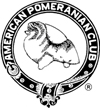Note: This is not the current version of the breed standard.
General Appearance- The Pomeranian in build and appearance is a cobby, balanced, short-coupled dog. He exhibits great intelligence in his expression, and is alert in character and deportment.
Size, Proportion, Substance – Size – The weight of the Pomeranian for exhibition is from three to seven pounds. The ideal size for show specimens is four to five pounds. Proportion – The Pomeranian in build and appearance is a cobby, balanced, short-coupled dog. The legs are of medium length in proportion to a well balanced frame. Substance – The body is well ribbed and rounded. The brisket is fairly deep and not too wide.
Head- Head well proportioned to the body, wedge-shaped, with a fox like expression. Eyes bright, dark in color, and medium in size, almond-shaped and not set too wide apart nor too close together. Pigmentation around eye rims must be black, except self-colored in brown and blue. Ears small, carried erect and mounted high on the head, and placed not too far apart. Skull not domed in outline. A round domey skull is a major fault. Muzzle – There is a pronounced stop with a rather fine but not snipy muzzle. Pigment around lips must be black, except self-colored in brown and blue. Bite – The teeth meet in a scissors bite, in which part of the inner surface of the upper teeth meets and engages part of the outer surface of the lower teeth. One tooth out of line does not mean an undershot or overshot mouth. An undershot mouth is a major fault.
Neck, Topline, Body- Neck – The neck is rather short, its base set well back on the shoulders. Topline is level. Body – The body is cobby, being well ribbed and rounded. Chest – The brisket is fairly deep and not too wide. Tail – The tail is characteristic of the breed. It turns over the back and carried flat, set high.
Forequarters – Shoulders – The Pom is not straight in shoulder, but has sufficient layback of shoulders to carry the neck proudly and high. Forelegs – The forelegs are straight and parallel, of medium length in proportion to a well balanced frame. Pasterns – The Pomeranian stands well up on toes. Down in pasterns is a major fault. Dewclaws on the forelegs may be removed. Feet – The Pomeranian stands well up on toes.
Hindquarters – Legs – The hocks are perpendicular to the ground, parallel to each other from hock to heel, and turn neither in nor out. Cow-hocks or lack of soundness in hind legs or stifles are major faults. Dewclaws, if any, on the hind legs are generally removed. Feet – The Pomeranian stands well up on toes.
Coat – Body Coat – Double-coated; a short, soft, thick undercoat, with longer, coarse, glistening outercoat consisting of guard hairs which must be harsh to the touch in order to give the proper texture for the coat to form a frill of profuse, standing-off straight hair. A soft, flat, or open coat is a major fault. Tail Coat – It is profusely covered with hair. Leg Coat – The front legs are well feathered and the hindquarters are clad with long hair or feathering from the top of the rump to the hocks. Trimming –Trimming for neatness is permissible around the feet and up the back of the legs to the first joint; trimming of unruly hairs on the edges of the ears and around the anus is also permitted. Overtrimming (beyond the location and amount described in the breed standard) should be heavily penalized.
Color –
Classifications – The Open
Classes at Specialty shows may be divided by
color as follows: Open Red, Orange, Cream
& Sable; Open Black, Brown & Blue;
Open Any Other Allowed Color.
Acceptable colors to be
judged on an equal basis. Any solid color,
any solid color with lighter or darker
shadings of the same color, any solid color
with sable or black shadings, parti-color,
sable and black & tan. Black & tan
is black with tan or rust, sharply defined,
appearing above each eye and on the muzzle,
throat, and forechest, on all legs and feet
and below the tail. Parti-color is white
with any other color distributed in even
patches on the body and a white blaze on
head. A white chest, foot, or leg on a
whole-colored dog (except white) is a major
fault.
Gait – The Pomeranian moves with a smooth, free, but not loose action. He does not elbow out in front nor move excessively wide nor cowhocked behind. He is sound in action.
Temperament – He exhibits great intelligence in his expression, and is alert in character and deportment.
Approved June 10, 1991

